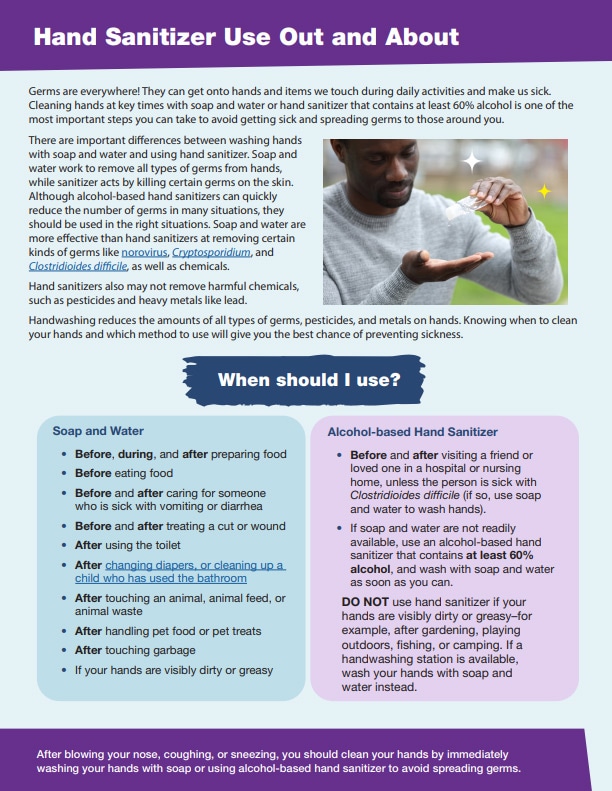Hand Sanitizer Use Out and About
Updated August 10, 2021

Germs are everywhere! They can get onto hands and items we touch during daily activities and make us sick. Cleaning hands at key times with soap and water or hand sanitizer that contains at least 60% alcohol is one of the most important steps you can take to avoid getting sick and spreading germs to those around you.
There are important differences between washing hands with soap and water and using hand sanitizer. Soap and water work to remove all types of germs from hands, while sanitizer acts by killing certain germs on the skin. Although alcohol-based hand sanitizers can quickly reduce the number of germs in many situations, they should be used in the right situations. Soap and water are more effective than hand sanitizers at removing certain kinds of germs like norovirus, Cryptosporidium, and Clostridioides difficile, as well as chemicals.
Hand sanitizers also may not remove harmful chemicals, such as pesticides and heavy metals like lead.
Handwashing reduces the amounts of all types of germs, pesticides, and metals on hands. Knowing when to clean your hands and which method to use will give you the best chance of preventing sickness.
CDC Health Advisory: Serious health problems caused by hand sanitizers containing methanol.

pdf icon[English] (PDF – 2 pages)
Soap and Water
- Before, during, and after preparing food
- Before eating food
- Before and after caring for someone who is sick with vomiting or diarrhea
- Before and after treating a cut or wound
- After using the toilet
- After changing diapers, or cleaning up a child who has used the bathroom
- After touching an animal, animal feed, or animal waste
- After handling pet food or pet treats
- After touching garbage
- If your hands are visibly dirty or greasy
Alcohol-based Hand Sanitizer
- Before and after visiting a friend or loved one in a hospital or nursing home, unless the person is sick with Clostridioides difficile (if so, use soap and water to wash hands).
- If soap and water are not readily available, use an alcohol-based hand sanitizer that contains at least 60% alcohol, and wash with soap and water as soon as you can.
DO NOT use hand sanitizer if your hands are visibly dirty or greasy—for example, after gardening, playing outdoors, fishing, or camping. If a handwashing station is available, wash your hands with soap and water instead.
After blowing your nose, coughing, or sneezing, you should clean your hands by immediately washing your hands with soap or using alcohol-based hand sanitizer to avoid spreading germs.
Soap and Water
- Wet your hands with clean running water (warm or cold), turn off the tap, and apply soap.
- Lather your hands by rubbing them together with the soap. Lather the backs of your hands, between your fingers, and under your nails.
- Scrub your hands for at least 20 seconds. Need a timer? Hum the “Happy Birthday” song twice.
- Rinse your hands under clean, running water.
- Dry your hands using a clean towel or air dry them.
Alcohol-based Hand Sanitizer
Use an alcohol-based hand sanitizer that contains at least 60% alcohol. Supervise young children when they use hand sanitizer to prevent swallowing alcohol, especially in schools and childcare facilities.
- Put enough sanitizer on your hands to cover all surfaces.
- Rub your hands together until they feel dry (this should take around 20 seconds).
Do NOT rinse or wipe off the hand sanitizer before it’s dry; it may not work well against germs.